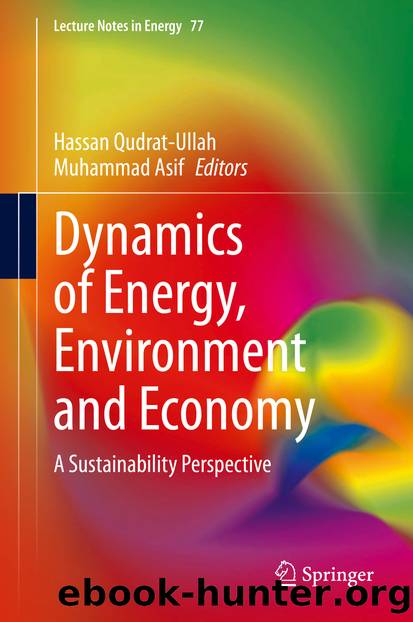Dynamics of Energy, Environment and Economy by Unknown

Author:Unknown
Language: eng
Format: epub
ISBN: 9783030435783
Publisher: Springer International Publishing
Space heating accounts for the highest energy consumption of Canadian residential buildings. Approximately 50% and 25% of the residential heating needs are catered by natural gas and electricity respectively. The heating performance of houses is significantly improved with higher penetration of energy efficient furnaces and improved building envelops (Natural Resources Canada 2019b; Karunathilake et al. 2018). Water heating is the second highest energy consumer of residential buildings. At present water heating is mainly done by natural gas and electricity with percentage contributions of 68% and 29% respectively (Natural Resources Canada 2019b). It is important to notice that use of heating oil, wood, and other fuels are significantly decreased over time. Efficiency of all major appliances such as refrigerators, freezers, dishwashers, clothes washers, and cloths driers have improved from 1990 to 2015. On the other hand, the use of minor appliances including electronics have increased over the time. Therefore, the energy savings generated by efficiency improvement of major appliances have been off-set by the minor appliances (Natural Resources Canada 2019b). Lighting energy requirements of a household has shown a huge reduction (18%) from 1990 to 2015. Natural Resources Canada (NRCan) attributes this efficiency improvement to multiple factors including the market penetration of LEDs, motion detectors, timers, task lighting, light dimmers, and behavioral practices such as turning-off unnecessary lamps (Natural Resources Canada 2019b; Karunathilake et al. 2018).
Over the past three decades, significant changes occurred in Canadian residential building sector. The number of households in Canada increased from 9.9 million to 14.1 million from 1990 to 2015 (Natural Resources Canada 2019b). The other noticeable change is the increase in the cooled area percentage with respect to occupied spaces (Natural Resources Canada 2011, 2019b). The percentage differences of the changes occurred from 1990 to 2015 in residential buildings are indicated in Fig. 8.4 below. These information are derived from statistics provided by NRCan (Natural Resources Canada 2019b).
Fig. 8.4Percentage differences of the changes occurred from 1990 to 2015
Download
This site does not store any files on its server. We only index and link to content provided by other sites. Please contact the content providers to delete copyright contents if any and email us, we'll remove relevant links or contents immediately.
Pale Blue Dot by Carl Sagan(4613)
The Rules Do Not Apply by Ariel Levy(4523)
Goodbye Paradise(3444)
Ogilvy on Advertising by David Ogilvy(3327)
Delivering Happiness by Tony Hsieh(3280)
Liar's Poker by Michael Lewis(3220)
Into Thin Air by Jon Krakauer(3127)
Purple Cow by Seth Godin(3069)
Rogue Trader by Leeson Nick(2824)
The Social Psychology of Inequality by Unknown(2759)
The Airbnb Story by Leigh Gallagher(2699)
4 - Harry Potter and the Goblet of Fire by J.K. Rowling(2530)
The Mind Map Book by Tony Buzan(2415)
Bossypants by Tina Fey(2373)
All the President's Men by Carl Bernstein & Bob Woodward(2260)
Claridge's: The Cookbook by Nail Martyn & Erickson Meredith(2257)
Six Billion Shoppers by Porter Erisman(2225)
Master of the Game by Sidney Sheldon(2181)
Alibaba by Duncan Clark(1979)
